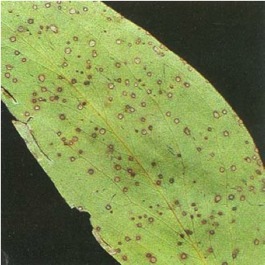PESTS AND DISEASES OF FORESTRY IN NEW ZEALAND
Sonderhenia Leaf Spots of Eucalyptus
Scion is the leading provider of forest-related knowledge in New Zealand
Formerly known as the Forest Research Institute, Scion has been a leader in research relating to forest health for over 50 years. The Rotorua-based Crown Research Institute continues to provide science that will protect all forests from damage caused by insect pests, pathogens and weeds. The information presented below arises from these research activities.
3. Sonderhenia Leaf Spots of Eucalyptus,
Forest Pathology in New Zealand No. 1.
Compiled: 1983, minor update 1990, revised 2009
Fungi: Sonderhenia eucalypticola (A.R. Davis) H.J. Swart & J. Walker
Sonderhenia eucalyptorum (Hansford) H.J. Swart & J. Walker
Note: Previously known as species of Hendersonia. A taxonomic review of the genus resulted in many species, including those recorded on Eucalyptus, being assigned to other genera.
Type of injury
Leaves become disfigured but tree growth is not usually affected. However, rare heavy infestations may cause premature leaf drop or reduce photosynthesis.

Fig. 3 - Sonderhenia eucalyptorum on Eucalyptus delegatensis .
Diagnostic features
Small (1-3 mm in diameter) spots with a distinct purple-red margin scattered over both upper and lower leaf surfaces. Spot surfaces are often raised. The two species of Sonderhenia form lesions that are very similar in appearance and cannot readily be distinguished. The species are separated microscopically on spore dimensions and they also differ in host association.
Hosts
Sonderhenia eucalypticola: Eucalyptus fraxinoides, E. globulus subsp. globulus, E. nicholii, E. nitens, E. sideroxylon
Sonderhenia eucalyptorum: Corymbia maculata, Eucalyptus delegatensis, E. elata, E. fastigata, E. fraxinoides, E. globoidea, E. johnstonii, E. leucoxylon, E. muelleriana, E. obliqua, E. regnans, E. viminalis.
Distribution
Throughout New Zealand except Northland.
Disease development
The asexual fruiting bodies, of which there are only between one and five per lesion, are completely submerged in the leaf tissue. In humid weather dark brown spores are exuded in a mass from the fruiting bodies and can be seen as minute dots on the leaf surface; they are presumably dispersed by rain splash. The main infection period is late summer and autumn. Mycosphaerella swartii, the sexual stage of S. eucalyptorum, is occasionally seen on the lesions. The sexual stage of S. eucalypticola has not been recorded In New Zealand.
Economic importance
Causes little damage. Rarely associated with minor defoliation.
Control
Not considered necessary.
Bibliography
Dick, M. 1982: Leaf-inhabiting fungi of eucalypts in New Zealand. New Zealand Journal of Forestry Science 12: 525-537.
Dick, M.; Gadgil, P.D. 1983: Eucalyptus leaf spots. New Zealand Forest Service, Forest Pathology in New Zealand No.1.
Gadgil, P.D. 2005: Fungi on trees and shrubs in New Zealand. Fungi of New Zealand Volume 4. Fungal Diversity Research Series 16: 1-437
Ridley, G.S.; Dick, M.A. 2001: An introduction to the diseases of forest and amenity trees in New Zealand. Bulletin 220. 110p.
This information is intended for general interest only. It is not intended to be a substitute for specific specialist advice on any matter and should not be relied on for that purpose. Scion will not be liable for any direct, indirect, incidental, special, consequential or exemplary damages, loss of profits, or any other intangible losses that result from using the information provided on this site.
(Scion is the trading name of the New Zealand Forest Research Institute Limited.)

 Farm Forestry New Zealand
Farm Forestry New Zealand

